#mountain west conference
Text
A 6'1 dude is competing against women and injuring them in the process. Yes contact sports always have the risk of injury, however the women are being injured more frequently when competing against him. And he's taking time away from his female teammates who should be the ones playing. But he doesn't care.
By Anna Slatz April 17, 2024
Reduxx has learned that a feminine male has been participating in elite women’s collegiate sports in California after his biological sex was reportedly withheld from his teammates and his opponents. Blaire Fleming, born Brayden, is currently playing women’s Division I volleyball for San Jose State University in the reputable Mountain West Conference.
Speaking to Reduxx, the mother of an opposing player revealed that her suspicions were first raised during the 2022-2023 season.
“I first watched my daughter play Blaire via live stream and then in person for a second match,” the mother, who wished to remain anonymous, said. “My daughter mentioned to me before the second match that there were rumors about Blaire being a male.”
Upon attending the match, she immediately noticed that Fleming appeared to be male, both in the way he looked and his mannerisms on the court.
“He jumped higher and hit harder than any woman on the court. There was no other female athlete on the court that day that could compare with Blaire’s athleticism. He also had very narrow hips. I took notice of how he was dressed with a longer shirt in the front as well.”

During the match, the anonymous parent noted that her daughter was suffering far more physical injuries and strains than she ever had before in her volleyball career, and was constantly icing and rubbing her arms after blocking shots from Fleming. She says her daughter’s teammates were also struggling, with the defenders being unable to react quickly to his high-intensity strikes.
“He was basically unstoppable at times. He was jumping so high that I was concerned our blockers could not defend against such a fast moving hit,” she says.
On average, the difference between upper body strength in the sexes is 52%, with men having 10% larger hands on average and being 7% taller. These factors have contributed to a volleyball net height difference of over 7 inches between male and female games. According to his San Jose Spartans profile, Fleming stands at 6’1.
“Coincidentally, those two games, my daughter’s stats were not as good as most other games. Her stats were dramatically different because she was trying to compete against a male who my daughter said would stare her down after plays and was extremely arrogant.”
The mother also revealed that despite widespread speculations that Fleming was male, officials from San Jose State let it slip to her daughter’s team that even they were unaware of his biological sex. She adds that the policies must change to ensure fairness for female athletes.
“I watched those San Jose State female athletes sit on the sidelines while a male took away their chance to play. These women only have 4 years to compete and they are losing those years to a male. Not only that, but the chance of injury is greatly increased for women when they play against a male with very clear physical strength advantages. It’s just dangerous above all else.”
Prior to transferring to San Jose, Fleming was participating in women’s volleyball in South Carolina for Coastal Carolina University. He appears to have fled to California just before the Save Women’s Sports Bill became law in the state, which would have prohibited him from continuing to play on female teams.
Fleming had also played on the girls varsity volleyball team at John Champe High School in Virginia, where he was raised. During this time, Fleming set the school record for most kills in a match, and single season record of 266 kills.
While the exact age Fleming was transitioned is unknown, early photos posted to his aunt’s Facebook show he was raised as a boy, and only began presenting in feminine clothing in 2016 when he would have been approximately 14 years old. His family members have been careful not to publicly identify him as transgender, but his grandmother referred to him as her “grandson” in an early photo.
Fleming is currently participating in Division I volleyball, which is the highest level of intercollegiate athletics sanctioned by the National Collegiate Athletic Association (NCAA). Division I (DI) volleyball teams can offer a maximum of 12 full-ride scholarships, meaning athletes will have all expenses related to their college experience paid for.
While it is currently unknown if Fleming has received a women’s DI scholarship, the NCAA has recently become the subject of a lawsuit by over one dozen female athletes for allowing males to compete against them in women’s categories.
The lawsuit, the first federal action of its kind, seeks to force the NCAA to change its policies to clearly define, rendering any biological males ineligible to compete against female athletes. It demands the NCAA revoke all awards given to trans athletes in women’s competitions and “reassign” them to their female contenders. It also asks for “damages for pain and suffering, mental and emotional distress, suffering and anxiety, expense costs and other damages due to defendants’ wrongful conduct.”
Exclusive funding support for the lawsuit is being provided by the Independent Council on Women’s Sports (ICONS), which has been calling attention to the presence and impact of male athletes in women’s categories.
Speaking to Reduxx on Blaire Fleming, ICONS’s Marshi Smith condemned the NCAA for failing to guarantee transparency or protection to female athletes who are forced to compete against men.
“The NCAA is defrauding female athletes by withholding information about a teammate or opponent’s true sex,” Smith says. “Women are not given the chance to decide whether they want to face heightened safety risks on the court or share women’s locker rooms with men. The NCAA’s reward system encourages deceit, leading to financial and academic advantages for males at the expense of girls and young women in sports. This harmful practice must be stopped immediately.”
Fleming is not the first trans-identified male athlete to conceal his biological sex for the purposes of participating in women’s collegiate sports.
As previously reported by Reduxx, a volleyball player from California was briefly set to become the first known male recipient of a women’s NCAA Division I athletic scholarship after successfully hiding his biological sex from his teammates.
Tate Drageset, 17, verbally committed to the University of Washington, but following the expose revealing his was a biological male, it was learned that the University rescinded the offer.
#Save women's sports Saturday#Title IX#california#usa#San Jose State University#Mountain west conference#Blaire Fleming is Brayden#Save Women’s Sports Bill#South Carolina#National Collegiate Athletic Association (NCAA)#Independent Council on Women’s Sports (ICONS)
24 notes
·
View notes
Text
New Mexico: 2023-24 Mountain West Men's Basketball Champions

On Wednesday, No. 6-seeded New Mexico entered the Mountain West Tournament firmly on the bubble—desperately needing at least two wins over No. 11 Air Force and No. 3 Air Force to keep their NCAA Tournament hopes alive.
When the final buzzer sounded Saturday, they became the first team in conference history to win four games in four days, earning a 68-61 victory over No. 5 San Diego State Saturday afternoon, clinching their fifth-ever MW Tournament title and first since 2017-18.
New Mexico also became the first No. 6 seed since 2002-03 (Colorado State) to win the MW Tournament—the only other No. 6 seed to win it. Though that previous bracket—with just eight teams (it did not have 11 until 2013-14)—lasted just three days.
The Lobos were led by dynamic All-Conference guards Jaelen House and Jamal Mashburn, who combined to score 49 of the team’s 68 points. House, who had a team-high 28 points, shot 10-of-22 from the floor and 3-of-7 from 3-point range. Mashburn tallied 21 points on 6-of-16 shooting with three triples as well, while JT Toppin finished with 13 points and 11 rebounds on 6-of-8 shooting, hauling in multiple key (offensive) rebounds down the stretch.
San Diego State, playing in their seventh consecutive Mountain West Title game, missed 13 of its final 14 shots after taking a four-point lead with 7:08 left. Jaedon LeDee was its only double-figure scorer, posting 25 points on 7-of-12 shooting with six rebounds.
New Mexico shot just 37.5 percent from the floor and 30.0 percent from 3-point range; SDSU shot just 35.7 percent and 20.0 percent from 3-point range. New Mexico forced 10 SDSU turnovers that led to 14 points off turnovers, while its four TOs didn’t lead to any additional Aztec points.
Three straight House triples gave the Lobos a nine-point lead with 6:44 left in the first half. Mashburn followed with a triple of his own before House’s fifth field goal of the contest widened their advantage to 32-18.
House and Mashburn ultimately scored 28 of New Mexico’s 36 points—including 24 of their final 26—in the first half, as the Lobos entered up by six. New Mexico shot 44.1 percent compared to San Diego State’s 44.4 percent. New Mexico held LeDee scoreless for the game’s first 17:30, swarming him on every catch inside 15 feet.
Waters’ three-point play followed by an eight-foot floater gave San Diego State their first lead of the evening. After Parrish’s first 3-pointer of the evening put San Diego State up four, two consecutive Toppin’ putbacks knotted the contest up at 57.
JT Toppin’s shot-clock beating finish gave New Mexico a 61-59 lead with 2:29 remaining. The knockout blow came with 1:20 left, when House’s drifting three-point play gave New Mexico its first two-possession lead in since the 14:30 left in the first half.
0 notes
Text
Mountain West Showdown: Fresno State vs. San Diego State - Who Takes the Crown?

Watch Online
The Mountain West conference heats up as Fresno State Bulldogs clash with the San Diego State Aztecs in a battle for conference bragging rights and crucial early-season momentum.
Both teams enter with hungry ambitions, but only one can leave Viejas Arena victorious.
This clash promises high-stakes drama, defensive intensity, and a fight for every inch of the hardwood.
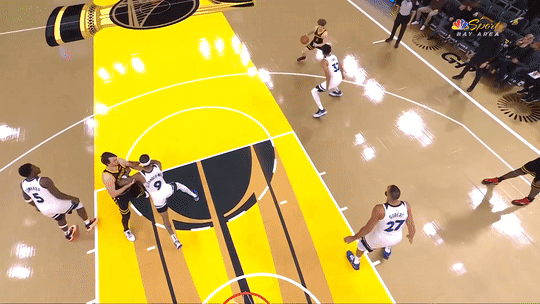
Fresno State Bulldogs: Gritty Underdogs Seeking Upset
The Bulldogs, under Head Coach Justin Hutson, embody the gritty underdog spirit. While boasting a 5-7 record, their losses often came against formidable opponents, showcasing their competitive edge.
Leading the charge is Isaiah Hill, a dynamic scorer averaging 18.9 points per game, whose offensive prowess can spark runs and keep them in the thick of things.
Their defense, averaging 66.3 points allowed per game, promises a physical battle and potential frustration for the Aztecs' potent offense.
San Diego State Aztecs: Defending Champs Facing Early Test
The Aztecs, under the reign of legendary Coach Brian Dutcher, are reigning Mountain West champions and harbor national championship aspirations.
They boast a 10-3 record, powered by a balanced attack led by Matt Bradley (12.1 ppg) and Darrion Trammell (11.9 ppg).
Their signature suffocating defense, allowing a conference-low 59.5 points per game, will test Fresno State's offensive execution and patience.
However, a recent one-point loss to Boise State raises questions about their vulnerability in close games.

Keys to the Game:
Can Fresno State exploit the Aztecs' recent defensive lapse? Hill's hot shooting hand and disciplined ball movement could challenge San Diego State's defensive intensity.
Will San Diego State's offense overpower Fresno State's gritty defense? Their balanced attack and offensive rebounding prowess could wear down the Bulldogs' defensive intensity.
Home-court advantage plays a role: Viejas Arena can become a electric cauldron, potentially providing an additional edge for the Aztecs.
Prediction:
This promises to be a tight and defensive battle, with both teams fighting for every possession.
While San Diego State's talent and experience give them a slight edge, Fresno State's underdog grit and potential offensive explosion could upset the balance.
Expect a nail-biter down to the wire, with the potential for a shocking result.

Beyond the Scoreboard:
This game isn't just about points and victories; it's about setting the tone for the Mountain West season.
A win for Fresno State could launch them into conference contention, while a victory for San Diego State reaffirms their dominance and championship aspirations.
Regardless of the outcome, this clash promises to be a showcase of Mountain West basketball's intensity and defensive prowess, leaving fans on the edge of their seats until the final buzzer.
Checkout Now
#Mountain West Conference#Fresno State Bulldogs#San Diego State Aztecs#Isaiah Hill#Matt Bradley#Darrion Trammell#Brian Dutcher#Justin Hutson#Viejas Arena#srkshaju#srkshazu#Basketball#basketball shorts#Fresno State vs. San Diego State
1 note
·
View note
Text



114th Border War Game
Wyoming Cowboys at Colorado State Rams
Saturday, November 12, 2022
Canvas Stadium, Colorado Springs, CO
#University of Wyoming#Wyoming#UW#Wyoming Cowboys#Cowboys#Pokes#Colorado State University#Colorado State#CSU#Colorado State Rams#Rams#Mountain West Conference#Mountain West#MW#NCAA#Football
0 notes
Text




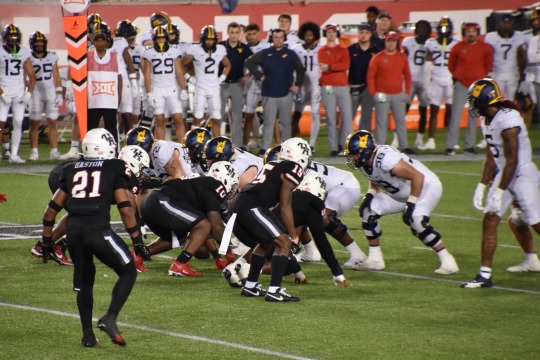
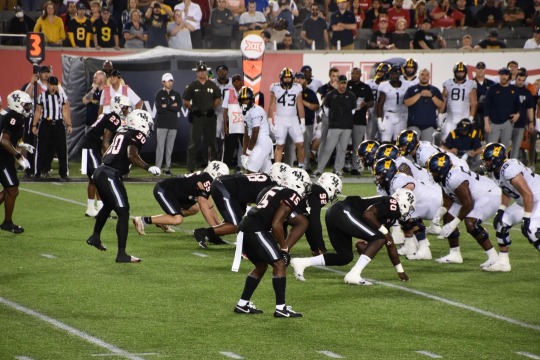
Houston Cougars
#houston cougars#west virginia mountaineers#big 12 conference#college football#sports#photography#nikon#tamron
1 note
·
View note
Text
#AAC Expansion#Apple TV Plus#College Football Landscape#Conference Realignment#Conference Shakeup#Media Deals#Mountain West Merge#Pac 12#Pac 12 Crisis#Pac 12 Future#Pac West Proposal#Sports Streaming#Streaming Sports
0 notes
Text
Cordeiro accounts for 4 TDs, San Jose State routs UNLV 40-7
Cordeiro accounts for 4 TDs, San Jose State routs UNLV 40-7
SAN JOSE, Calif. — Chevan Cordeiro accounted for four touchdowns to lead San Jose State to a 40-7 rout of UNLV on Friday night.
Cordeiro was 18-of-27 passing for 230 yards and added 109 yards on the ground with touchdown runs from 10 and 15 yards. His 22-yard touchdown pass to Dominick Mazotti stretched the San Jose State (4-1, 2-0 Mountain West Conference) lead to 33-0 midway through the third…
View On WordPress
#California#College Football#College sports#Dominick Mazotti#Football#Kairee Robinson#Mountain West Conference football#north america#San Jose#San Jose State Spartans football#Sports#united states#UNLV Rebels football
0 notes
Text
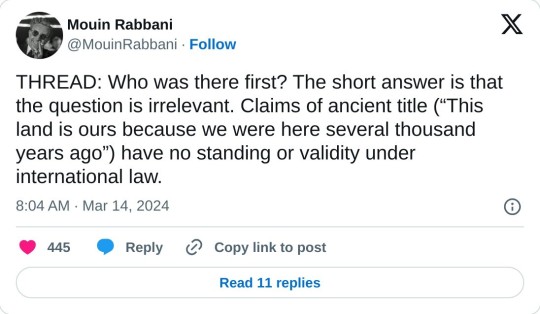
twitter thread by Mouin Rabbani
March 14, 2024
Who was there first? The short answer is that the question is irrelevant. Claims of ancient title (“This land is ours because we were here several thousand years ago”) have no standing or validity under international law.
For good reason, because such claims also defy elementary common sense. Neither I nor anyone reading this post can convincingly substantiate the geographical location of their direct ancestors ten or five or even two thousand years ago.
If we could, the successful completion of the exercise would confer exactly zero property, territorial, or sovereign rights.
As a thought experiment, let’s go back only a few centuries rather than multiple millennia. Do South Africa’s Afrikaners have the right to claim The Netherlands as their homeland, or even qualify for Dutch citizenship, on the basis of their lineage?
Do the descendants of African-Americans who were forcibly removed from West Africa have the right to board a flight in Atlanta, Port-au-Prince, or São Paolo and reclaim their ancestral villages from the current inhabitants, who in all probability arrived only after – perhaps long after – the previous inhabitants were abducted and sold into slavery half a world away?
Do Australians who can trace their roots to convicts who were involuntarily transported Down Under by the British government have a right to return to Britain or Ireland and repossess homes from the present inhabitants even if, with the help of court records, they can identify the exact address inhabited by their forebears? Of course not.
In sharp contrast to, for example, Native Americans or the Maori of New Zealand, none of the above can demonstrate a living connection with the lands to which they would lay claim.
To put it crudely, neither nostalgic attachment nor ancestry, in and of themselves, confer rights of any sort, particularly where such rights have not been asserted over the course of hundreds or thousands of years.
If they did, American English would be the predominant language in large parts of Europe, and Spain would once again be speaking Arabic.
Nevertheless, the claim of ancient title has been and remains central to Zionist assertions of not only Jewish rights in Palestine, but of an exclusive Jewish right to Palestine.
For the sake of argument, let’s examine it. If we put aside religious mythology, the origin of the ancient Israelites is indeed local.
In ancient times it was not unusual for those in conflict with authority or marginalized by it to take to the more secure environment of surrounding hills or mountains, conquer existing settlements or establish new ones, and in the ultimate sign of independence adopt distinct religious practices and generate their own rulers. That the Israelites originated as indigenous Canaanite tribes rather than as fully-fledged monotheistic immigrants or conquerors is more or less the scholarly consensus, buttressed by archeological and other evidence. And buttressed by the absence of evidence for the origin stories more familiar to us.
It is also the scholarly consensus that the Israelites established two kingdoms, Judah and Israel, the former landlocked and covering Jerusalem and regions to the south, the latter (also known as the Northern Kingdom or Samaria) encompassing points north, the Galilee, and parts of contemporary Jordan. Whether these entities were preceded by a United Kingdom that subsequently fractured remains the subject of fierce debate.
What is certain is that the ancient Israelites were never a significant regional power, let alone the superpower of the modern imagination.
There is a reason the great empires of the Middle East emerged in Egypt, Mesopotamia, Persia, and Anatolia – or from outside the region altogether – but never in Palestine.
It simply lacked the population and resource base for power projection. Jerusalem may be the holiest of cities on earth, but for almost the entirety of its existence, including the period in question, it existed as a village, provincial town or small city rather than metropolis.
Judah and Israel, like the neighboring Canaanite and Philistine entities during this period, were for most of their existence vassal states, their fealty and tribute fought over by rival empires – Egyptians, Assyrians, Babylonians, etc. – rather than extracted from others.
Indeed, Israel was destroyed during the eighth century BCE by the Assyrians, who for good measured subordinated Judah to their authority, until it was in the sixth century BCE eliminated by the Babylonians, who had earlier overtaken the Assyrians in a regional power struggle.
The Babylonian Exile was not a wholesale deportation, but rather affected primarily Judah’s elites and their kin. Nor was there a collective return to the homeland when the opportunity arose several decades later after Cyrus the Great defeated Babylon and re-established a smaller Judah as a province of the Persian Achaemenid empire. Indeed, Mesopotamia would remain a key center of Jewish religion and culture for centuries afterwards.
Zionist claims of ancient title conveniently erase the reality that the ancient Israelites were hardly the only inhabitants of ancient Palestine, but rather shared it with Canaanites, Philistines, and others.
The second part of the claim, that the Jewish population was forcibly expelled by the Romans and has for 2,000 years been consumed with the desire to return, is equally problematic.
By the time the Romans conquered Jerusalem during the first century BCE, established Jewish communities were already to be found throughout the Mediterranean world and Middle East – to the extent that a number of scholars have concluded that a majority of Jews already lived in the diaspora by the time the first Roman soldier set foot in Jerusalem.
These communities held a deep attachment to Jerusalem, its Temple, and the lands recounted in the Bible. They identified as diasporic communities, and in many cases may additionally have been able to trace their origins to this or that town or village in the extinguished kingdoms of Israel and Judah. But there is no indication those born and bred in the diaspora across multiple generations considered themselves to be living in temporary exile or considered the territory of the former Israelite kingdoms rather than their lands of birth and residence their natural homeland, any more than Irish-Americans today feel they properly belong in Ireland rather than the United States.
Unlike those taken in captivity to Babylon centuries earlier, there was no impediment to their relocation to or from their ancestral lands, although economic factors appear to have played an important role in the growth of the diaspora.
By contrast, those traveling in the opposite direction appear to have done so, more often than not, for religious reasons, or to be buried in Jerusalem’s sacred soil.
Nations and nationalism did not exist 2,000 years ago.
Nor Zionist propagandists in New York, Paris, and London incessantly proclaiming that for two millennia Jews everywhere have wanted nothing more than to return their homeland, and invariably driving home rather than taking the next flight to Tel Aviv.
Nor insufferably loud Americans declaring, without a hint of irony or self-awareness, the right of the Jewish people to Palestine “because they were there first”.
Back to the Romans, about a century after their arrival a series of Jewish rebellions over the course of several decades, coupled with internecine warfare between various Jewish factions, produced devastating results.
A large proportion of the Jewish population was killed in battle, massacred, sold into slavery, or exiled. Many towns and villages were ransacked, the Temple in Jerusalem destroyed, and Jews barred from entering the city for all but one day a year.
Although a significant Jewish presence remained, primarily in the Galilee, the killings, associated deaths from disease and destitution, and expulsions during the Roman-Jewish wars exacted a calamitous toll.
With the destruction of the Temple Jerusalem became an increasingly spiritual rather than physical center of Jewish life. Jews neither formed a demographic majority in Palestine, nor were the majority of Jews to be found there.
Many of those who remained would in subsequent centuries convert to Christianity or Islam, succumb to massacres during the Crusades, or join the diaspora. On the eve of Zionist colonization locally-born Jews constituted less than five per cent of the total population.
As for the burning desire to return to Zion, there is precious little evidence to substantiate it. There is, for example, no evidence that upon their expulsion from Spain during the late fifteenth century, the Sephardic Jewish community, many of whom were given refuge by the Ottoman Empire that ruled Palestine, made concerted efforts to head for Jerusalem. Rather, most opted for Istanbul and Greece.
Similarly, during the massive migration of Jews fleeing persecution and poverty in Eastern Europe during the nineteenth century, the destinations of choice were the United States and United Kingdom.
Even after the Zionist movement began a concerted campaign to encourage Jewish emigration to Palestine, less than five per cent took up the offer. And while the British are to this day condemned for limiting Jewish immigration to Palestine during the late 1930s, the more pertinent reality is that the vast majority of those fleeing the Nazi menace once again preferred to relocate to the US and UK, but were deprived of these havens because Washington and London firmly slammed their doors shut.
Tellingly, the Jewish Agency for Israel in 2023 reported that of the world’s 15.7 million Jews, 7.2 million – less than half – reside in Israel and the occupied Palestinian territories.
According to the Agency, “The Jewish population numbers refer to persons who define themselves as Jews by religion or otherwise and who do not practice another religion”.
It further notes that if instead of religion one were to apply Israel’s Law of Return, under which any individual with one or more Jewish grandparent is entitled to Israeli citizenship, only 7.2 of 25.5 million eligible individuals (28 per cent) have opted for Zion.
In other words, “Next Year in Jerusalem” was, and largely remains, an aspirational religious incantation rather than political program. For religious Jews, furthermore, it was to result from divine rather than human intervention.
For this reason, many equated Zionism with blasphemy, and until quite recently most Orthodox Jews were either non-Zionist or rejected the ideology altogether.
Returning to the irrelevant issue of ancestry, if there is one population group that can lay a viable claim of direct descent from the ancient Israelites it would be the Samaritans, who have inhabited the area around Mount Gerizim, near the West Bank city of Nablus, without interruption since ancient times.
Palestinian Jews would be next in line, although unlike the Samaritans they interacted more regularly with both other Jewish communities and their gentile neighbors.
Claims of Israelite descent made on behalf of Jewish diaspora communities are much more difficult to sustain. Conversions to and from Judaism, intermarriage with gentiles, absorption in multiple foreign societies, and related phenomena over the course of several thousand years make it a virtual certainty that the vast majority of Jews who arrived in Palestine during the late 19th and first half of the 20th century to reclaim their ancient homeland were in fact the first of their lineage to ever set foot in it.
By way of an admittedly imperfect analogy, most Levantines, Egyptians, Sudanese, and North Africans identify as Arabs, yet the percentage of those who can trace their roots to the tribes of the Arabian Peninsula that conquered their lands during the seventh and eighth centuries is at best rather small.
Ironically, a contemporary Palestinian, particularly in the West Bank and Galilee, is likely to have more Israelite ancestry than a contemporary diaspora Jew.
The Palestinians take their name from the Philistines, one of the so-called Sea Peoples who arrived on the southern coast of Canaan from the Aegean islands, probably Crete, during the late second millennium BCE.
They formed a number of city states, including Gaza, Ashdod, and Ashkelon. Like Judah and Israel they existed primarily as vassals of regional powers, and like them were eventually destroyed by more powerful states as well.
With no record of their extermination or expulsion, the Philistines are presumed to have been absorbed by the Canaanites and thereafter disappear from the historical record.
Sitting at the crossroads between Asia, Africa, and Europe, Palestine was over the centuries repeatedly conquered by empires near and far, absorbing a constant flow of human and cultural influences throughout.
Given its religious significance, pilgrims from around the globe also contributed to making the Palestinian people what they are today.
A common myth is that the Palestinian origin story dates from the Arab-Muslim conquests of the seventh century. In point of fact, the Arabs neither exterminated nor expelled the existing population, and the new rulers never formed a majority of the population.
Rather, and over the course of several centuries, the local population was gradually Arabized, and to a large extent Islamized as well.
So the question as to who was there first can be answered in several ways: “both” and “irrelevant” are equally correct.
Indisputably, the Zionist movement had no right to establish a sovereign state in Palestine on the basis of claims of ancient title, which was and remains its primary justification for doing so.
That it established an exclusivist state that not only rejected any rights for the existing Palestinian population but was from the very outset determined to displace and replace this population was and remains a historical travesty.
That it as a matter of legislation confers automatic citizenship on millions who have no existing connection with the land but denies it to those who were born there and expelled from it, solely on the basis of their identity, would appear to be the very definition of apartheid.
The above notwithstanding, and while the Zionist claim of exclusive Israeli sovereignty in Palestine remains illegitimate, there are today several million Israelis who cannot be simply wished away.
A path to co-existence will need to be found, even as the genocidal nature of the Israeli state, and increasingly of Israeli society as well, makes the endeavor increasingly complicated.
The question, thrown into sharp relief by Israel’s genocidal onslaught on the Palestinian population of the Gaza Strip, is whether co-existence with Israeli society can be achieved without first dismantling the Israeli state and its ruling institutions.
253 notes
·
View notes
Text
An idea I am toying around with for my Watchers (Reverse robins) au
Wally leaned back against the wall watching as people walked around the room talking. He didn't really want to be here but Barry was at a conference so he was staying at Wayne Manner for the weekend.
It wasn't unusual for Wally to crash at the Bats, it was like a second home. Bruce didn't really mind as Wally was Damian's only best friend even if Damian refused to acknowledge it.
Sadly for Damian, he was pulled aside an hour ago to make small talk with some of Bruce's associates leaving Wally on his own. Wally sighed pulling out his phone.
"West it's disrespectful to be on your phone at a gala" Damian walked up beside him. Wally couldn't help but chuckle that Damian of all people was fusing at him for being disrespectful.
"Sorry Galas really aren't my thing" Wally sighed putting his phone up.
"Then why did you come?" Damian inquired.
"Free food" the redhead smiled holding up his plate "So you got away?"
"Yeah finally, I don't understand how those people can go on and on about nonsense, No one cares that you went skiing on some mountain," Damian said letting all his frustration out.
"Tell me about it" Wally laughed. The two started talking when some man in a blue suit walked up to them.
"Ah Damian Wayne" the man greeted him with a smile "How is your father"
"He's fine" Damian tone was sharp
"That good to hear I got these for you," he said handing a box of donuts.
"Thank you" Damian replied the keeping same tone.
"Tell your father to stop by sometime" The man smiled before leaving.
"And you were fussing at me for being rude" Wally laughed "That guy was being nice and you looked like you were going to slit his throat"
"Nice? Please" Damian huffed "he owns one of the largest electromagnetic companies in the US he just wants to get in good with my father so that can do business"
"At least you got Jelly donuts" Wally shrugged.
"Ah yeah, nothing like artificial dyes and flavoring" Damian responded.
"If you don't want I'll take it" Wally offered. Damian rolled his eyes handing him the box. "Sweet" Wally grinned stuffing one in his mouth. It was a lot sweeter than he expected but still good.
"How can you eat that garbage" Damian scuffed.
"These are awesome," Wally said grabbing the other one. The two talked for a total of five minutes before Damian was once again pulled away.
"Damian!" Bruce waved over from across the room.
"Oh joy" Damian sighed walking away. Wally went back to look at his phone. The light of the phone seemed awfully bright Wally thought putting his phone back up. He hadn't realized how tired he was. He should probably head on to bed not like anyone would miss him any
Halfway down the hallway, Wally found himself leaning on the wall. He was a lot more tired than he thought. Slowly he slumped down to the floor. He would just sit here and rest his eyes for a minute.
"You're not seriously taking a nap in the hallway" Wally's eyes fluttered open. Damian stood in front of him looking a little annoyed.
"..." Wally opened his mouth to respond but no words came out instead he just closed it back. When did breathing become such a hassle?
"West?" Damian moved close bending down in front of him. Why was he flashing that light in his eye? Wally tried to swat the light away but his arms refused to obey.
Damian lowered the flashlight and turned his head to yell something Wally couldn't quite catch before turning back around.
Damian looked worried, that's weird. Was something wrong? His mouth was moving but Wally couldn't make out what he was saying. Something was wrong. Wally needed to get up, Damian needed help but Wally's eyelids felt so heavy.
He'd just rest for a few minutes then he could help Damian. Wally closed his eyes allowing everything to fade into dark.
.
.
.
love to hear feedback
37 notes
·
View notes
Text
Two women ... locked themselves to a massive drill, stopping work on a controversial oil pipeline project. One of the women, Rose Abramoff is believed to be the first American climate scientist to risk a felony in an act of climate protest against fossil fuel projects.
“The stakes are so high,” Abramoff told the Guardian. “We cannot build this pipeline and meet our climate goals.”
The Mountain Valley Pipeline would stretch 300 miles across West Virginia and Virginia, transporting liquified shale gas. The US supreme court made a ruling in July to allow construction to resume on the $6.6bn pipeline, which has been championed by Senator Joe Manchin.
According to Scientist Rebellion, over two dozen work stoppages such as lockdowns, rallies and walk-ons have taken place at the Mountain Valley pipeline construction site in the past two months. ...
Abramoff has a long history of climate activism. ... In December of last year, Abramoff interrupted the American Geophysical Union meeting, calling on fellow scientists to join her in climate activism. In response, she was expelled from the conference and lost her job. ...
For Abramoff, the risk of going to prison is scary, but the alternative is unthinkable: “We can’t keep expanding fossil fuels. It just can’t happen.”
44 notes
·
View notes
Text
San Diego State: 2022-23 Mountain West Men's Basketball Champions

LAS VEGAS (AP) — Jaedon LeDee scored 15 points and Matt Bradley added 14 to lead No. 20 San Diego State to a 62-57 victory over Utah State in Saturday's Mountain West Tournament championship game.
The Aztecs (27-6) claimed their seventh tournament title, and second in three years. This also was their conference-record 15th appearance in the title game.
San Diego State clinched the conference's bid to the NCAA Tournament, though it was never in doubt the Aztecs would be selected. What kind of seed San Diego State receives remains to be seen.
Utah State (26-8) also figures to be headed to the tournament when the selections are announced Sunday.
This was the fourth time in the last five years the teams have played each other in the Mountain West championship game. Utah State won the 2019 and 2020 title games, and San Diego State went home with the 2021 trophy. Boise State temporarily ended the monopoly last season by beating the Aztecs 53-52.
Neither team shot well Saturday, with San Diego State making 33.3% of its shots compared to 37.1% for the Aggies.
No San Diego State players reached double-figure scoring other than Ledee and Mitchell. For Utah State, Steven Ashworth scored 13 points and Trevin Dorius 12.
The Aggies were hot early, however, going on a 12-2 run in the first half to take a 26-15 lead with 6:57 left, but then went cold. They failed to make another field goal until 1:43 into the second half, but somehow didn't fall behind during that stretch.
But the Aztecs got close, and eventually went back and forth with Utah State in the second half. San Diego State nearly put away the game by going up 53-46 with 3:03 left, but the Aggies got back to within three points with 48 seconds remaining and two points with 30.3 seconds to go.
San Diego State closed out the game at the free throw line by making 9 of 10 free throws in the final 43 seconds.
THE BIG PICTURE
Utah State: The Aggies entered the game fourth nationally in 3-point percentage at 40.1, but struggled badly against San Diego State's long, athletic defense. Utah State made just 4 of 24 3-point attempts.
San Diego State: The Aztecs come in waves. Nine players were in the game, and each was on the floor for at least 16 minutes and eight at least 19. All nine scored and collected rebounds.
UP NEXT
Utah State: The Aggies have a NET ranking of No. 18, so it would be quite a surprise if they aren't selected to the NCAA Tournament.
San Diego State: A potential six seed could be coming San Diego State's way, but the Aztecs also might have worked their way into a No. 5.
AP college basketball: https://apnews.com/hub/college-basketball and https://apnews.com/hub/ap-top-25-college-basketball-poll and https://twitter.com/AP_Top25
0 notes
Text
Last Saturday's championship game between Oregon and Washington marked the unofficial end of one of the sport's longtime power conferences.
Ten of the 12 member schools are set to join a different conference in 2024, effectively dissolving the Pac 12, a conference that has existed since 1915.

Now it's just the Pac-2 with only Oregon State and Washington State left who have announced a six-game scheduing agreement with the Mountain West. What happens after next season is uncertain.
#nfl#pac 12 football#oregon ducks#washington huskies#stanford cardinal#ucla bruins#usc trojans#colorado buffaloes#arizona widcats#arizona state sun devils#utah utes#california golden bears#washington state cougars#oregon state beavers
21 notes
·
View notes
Text
Updated! Upcoming Vintage Computer Festivals
Do you like vintage computers, and want to interact with the community at large? Well, here are the upcoming VCF events for the United States in 2023:
Vintage Computer Festival Southwest: June 23, 24, & 25 - Davidson-Gundy Alumni Center at UT, Dallas, TX https://www.vcfsw.org/. This one is returning after about a decade, and is being organized by a new team of people.
Vintage Computer Festival Southeast: July 28, 29, & 30 - Marriott Renaissance Waverly, Atlanta, GA - https://vcfed.org/events/otherevents/vintage-computer-festival-southeast/. Part of the Southern Fried Gaming Expo.
Vintage Computer Festival West: Tentatively, August 4 & 5 - The Computer History Museum, Mountain View, CA - https://vcfed.org/events/vintage-computer-festival-west/ Note: event will happen Friday and Saturday this year, due to a scheduling conflict on Sunday.
Vintage Computer Festival Midwest: September 9 & 10 - Waterford Banquet & Conference Center, Elmhurst, IL - https://vcfmw.org/
That's a VCF every month for the next 4 month!
29 notes
·
View notes
Text

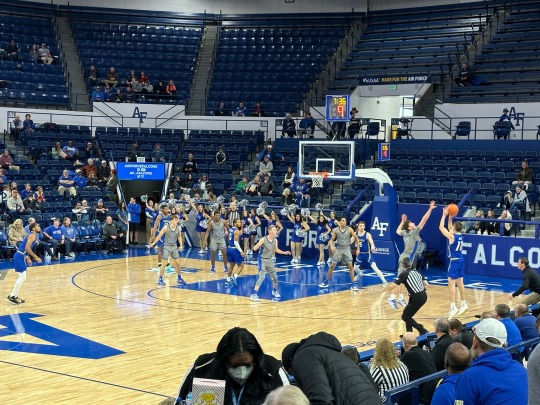


Delaware Blue Hens at Air Force Falcons
Friday, November 11, 2022
Clune Arena, USAF Academy, CO
#University of Delaware#UD#Delaware#Delaware Blue Hens#Blue Hens#Colonial Athletic Association#CAA#United States Air Force Academy#USAFA#Air Force#Air Force Falcons#Falcons#Mountain West Conference#Mountain West#MW#NCAA#Basketball
0 notes
Text
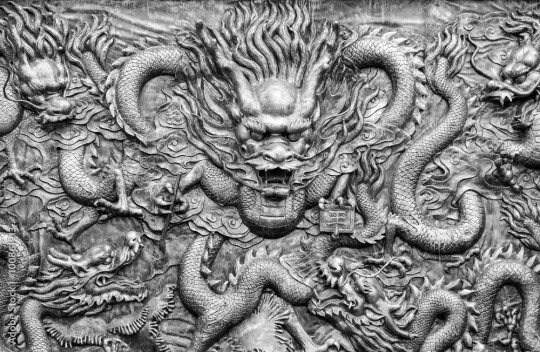
How to Worship Your Dragon: Julia Vee & Ken Bebelle Advise
Julia Vee & Ken Bebelle wrote a book that’s like female John Wick with dragon magic and it’s called Ebony Gate and guess what! It’s out TODAY. We actually have Julia & Ken with us as special guests for Dragon Week, so check out their scholarly article on rituals of dragon worship, and then check out their high octane urban fantasy full of magic and assassins!
Check it out!
A Brief Description of Rituals to Worship Chinese Dragons by Julia Vee & Ken Bebelle
1. Make Your Annual Pilgrimage to a Local Dragon King and Dragon Mother Temple For Blessings
Dragon King and Dragon Mother temples dot the Asian countryside. If you are in the northern reaches of China, get yourself to the Heilongdawang Temple (literally “Black Dragon Great King”) located in Longwanggou (“Dragon King Valley”) in Shaanxi province where you can njoy six days of festivities.
Modern Chinese scholars note that folkloric traditions and religions are having a revival.1 And why not? Festivities for the Great Black Dragon King include opera, dancers, circus performers, games, fireworks, and of course, gambling. This particular dragon king is more highly regarded than other local dragon kings because of his imperially conferred official title–the Marquis of Efficacious Response (Lingyinghou, 灵应侯).2
The Heilongdawang festival draws hundreds of thousands of pilgrims, all ready to donate generously to the temple coffers, burn incense, and otherwise eat copious quantities at the food stalls.
Or you can participate in a rain-summoning ceremony. In the drought-prone north, one ritual to summon rain included “casting tiger bones into a pool of water in order to scare dragons into flight, thereby creating rainclouds.”3
If you are in southern China, on the eighth day of the fifth month on the lunar calendar, you can join in with over a hundred thousand pilgrims to visit the Dragon Mother Temple in Guangdong. This temple sits along the Xijiang River and leans against Wulong (Five Dragons) Mountain. The area is known as the Pearl River Delta, and Dragon Mother devotees are spread widely across the West river and into Hong Kong and Macau. The Lung Mo temple on Pengchau island (Hong Kong) is situated on the beach.
The origins of the Dragon Mother reach back longer than the established official story, which goes something like this:
There was a young woman named Wen from Wuzhou. One day while washing clothes in the West River, she found a giant stone. From the stone sprung five lizards, who grew into dragons. She raised them tenderly and when her village had drought, the dragons brought rain. When the river threatened to flood, the dragons were there to divert the floodwaters. When she was quite elderly, the Emperor summoned her to the capital. Her dragon sons prevented the arduous journey (which was by river of course). When she passed away in 211 B.C. her dragon sons were devastated and transformed into five human scholars who held her funeral rites and buried her in Jiangwan.
Later, she was elevated in status to a deity, rising to the heavens as an immortal.
Pilgrims consider this eighth day of the fifth lunar month the Dragon Mother’s birthday and observe time-honored rituals. First, they wash their hands in the Dragon Spring to clean off the worldly dirt. The pilgrims then burn incense and present gifts at the temple. They bow, then kneel on the floor, and pray to the goddess. After this devotion, they light off firecrackers to respectfully invite the Dragon Mother to receive their gifts and fulfill their wishes.4
As one scholar notes, “It is not a coincidence that the pilgrimage to the Dragon Mother Temple falls on the eighth day of the fifth lunar month, as the fifth lunar month was the time when the danger of seasonal flooding of the West River (which is commonly known as “xiliao 西 潦,” literally “west flood”) was the most imminent. The West River therefore was both a lifeline and a constant threat to the local people, who felt a real need to appease the river as well as to express their gratitude to the river goddess on this annual festive occasion.”5
The Dragon Mother and other water goddess (“Shuimu”) traditions go back millennia and it’s not hard to see why. The specter of drought, famine, or flooding was constant. Seafaring populations too, had multiple goddesses they sought blessings from for their safe voyage (Dragon Mother, Sea Goddess Mazu, and the shuimu (“Water Goddess”).
In 1861, John Henry Gray observed a ceremony to the Dragon Mother:
“…On a small temporary altar, which had been erected for the occasion, stood three cups containing Chinese wine. Taking in his hands a live fowl, which he continued to hold until he killed it as a sacrifice, the master proceeded in the first place to perform the Kowtow. He then took the cups from the table, one at a time, and, raising each above his head, poured its contents on the deck as a libation. He next cut the throat of the fowl with a sharp knife, taking care to sprinkle that portion of the deck on which he was standing with the blood of the sacrifice. At this stage of the ceremony several pieces of silver paper were presented to him by one of the crew. These were sprinkled with the blood, and then fastened to the door-posts and lintels of the cabin.”6
It wasn’t just sailors and locals to the West river who observed such pilgrimages and prayer rituals. When there was a drought, even government officials were tasked with conducting prayers to the Dragon King.
2. Failure to Worship the Dragon King, or Worse, Destruction of a Dragon King Temple, Can Lead to Heaven-Sent Disaster!
During the Great Flood of 1931 in Wuhan, one official lamented that the people blamed the flood on the destruction of a Dragon King Temple.7 The Dragon King Temple in Hankou had been demolished in 1930 to make way for a new road, so the timing of the flood was uncanny.
This flood affected 53 million people. The officials of Wuhan had to repent. Several prominent officials of Wuhan participated in rituals designed to placate the Dragon King, including the mayor. They kowtowed to the Dragon King altar, beseeching the deity to spare Wuhan from the flood.
Citizens of the region also blamed officials for outlawing the singing of “spirit operas” traditionally performed to assuage flood dragons.8
To those who worshiped the Dragon King, destroying his temple that sat atop the dyke was clearly a bad idea.
3. Maybe a River Near You Has a Dragon Deity.
Even if a Dragon King or Dragon Mother temple isn’t available, you can still make a pilgrimage to the rivers. At least forty rivers in China are named for dragons including these rivers in Shanghai: Shanghai: Longquangang He 龍泉港河 (Dragon Spring Port River), Bailonggang He 白龍港河 (White Dragon Port River).9
Just be sure to be properly deferential, and perhaps offer a song to the river dragon.
—Julia Vee & Ken Bebelle
We would like to thank Dr. Yasmin Koppen of University Leipzig for her friendship, and generously sharing her expertise and scholarship in East Asian dragons.

Works Cited
Chau, Adam Yuet “Mysterious Response: Doing Popular Religion in Contemporary China” (Stanford: Stanford University Press, 2006) 88.
Fan Lizhu and Chen Na “Resurgence of Indigenous Religion in China” (2013) 11.
Courtney, Chris “The Dragon King and the 1931 Wuhan Flood: Religious Rumors and Environmental Disasters in Republican China” (University of Cambridge, Twentieth-Century China 40.2, May 2015) p. 88.
Tan, Weiyun “Dragon mother temple keeps legend alive for 2 millennia” Shine, Nov. 12, 2021 https://www.shine.cn/feature/art-culture/2111128066/
Poon, Shuk-Wah. "Thriving Under an Anti-Superstition Regime: The Dragon Mother Cult in Yuecheng, Guangdong, During the 1930s." Journal of Chinese Religions 43, no. 1 (2015): 34-58. muse.jhu.edu/article/708611.
Poon, pg 41.
Courtney at p. 83.
Courtney at p. 100.
Zhao, Qiguang Chinese Mythology in the Context of Hydraulic Society Asian Folklore Studies Vol. 48, No. 2 (1989), pp. 231-246.
cindyxiong. “Ancient Bronze Dragons Carving in the Ancient Dragon King Temple along Yangtze River,China. Foreign Text Means King. Stock Photo.” Adobe Stock, stock.adobe.com/images/ancient-bronze-dragons-carving-in-the-ancient-dragon-king-temple-along-yangtze-river-china-foreign-text-means-king/100861913?prev_url=detail. Accessed 6 July 2023.
14 notes
·
View notes